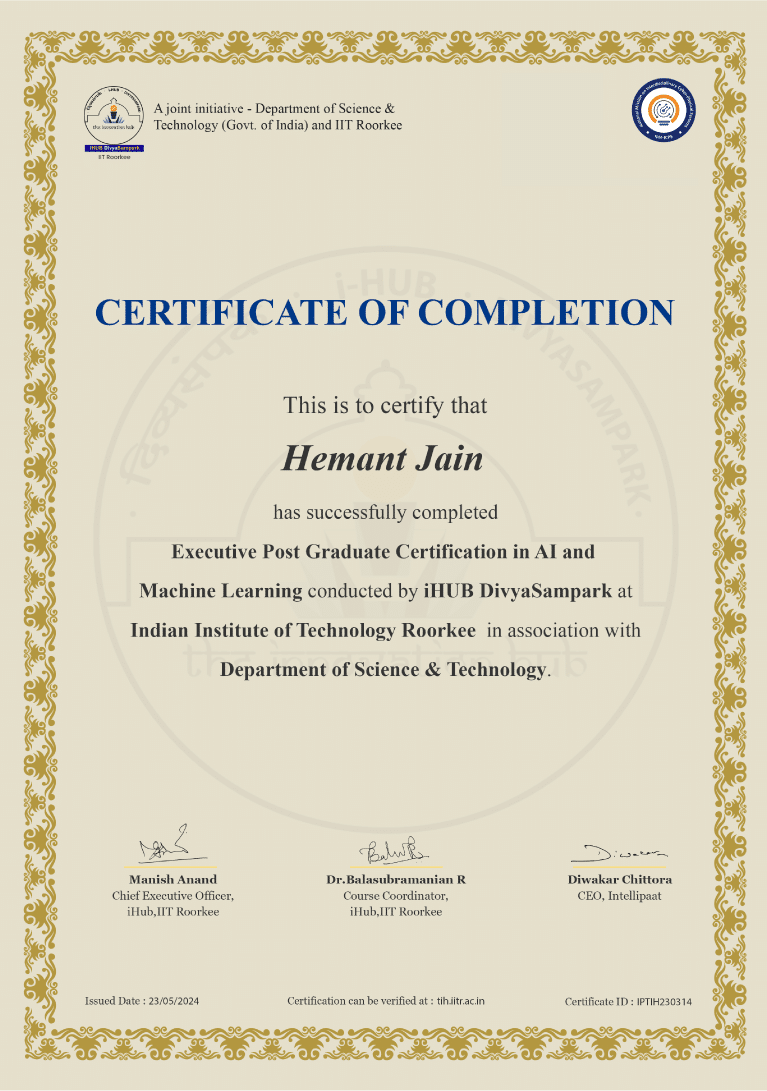Your cart is currently empty.







Gain expertise in Artificial intelligence and Machine Learning through an Executive Post Graduate Certification program in AI and ML offered by iHUB DivyaSampark, a Technology Innovation Hub of IIT Roorkee, in collaboration with Intellipaat This AI and ML program is in collaboration with tech giants Microsoft. Get classes and guidance directly from IIT Faculty and industry experts, with personalized 1:1 mentorship. Become IIT certified AI and ML expert with this online bootcamp.

Watch
Course PreviewLearning Format
Online Bootcamp
Live Classes
11 Months
iHub - IIT Roorkee
Certification
Campus Immersion
iHUB, IIT Roorkee
EMI Starts
at ₹6999/month*
This online artificial intelligence and machine learning Executive Post Graduate Certification course conducted by the IIT Faculty aims to help you master all the basic and advanced level skills that are crucial in the field of AI and ML. With an updated syllabus, keeping the trending generative AI models in focus, this course is designed to shape your development skills with the demanding trends in the industry.
About iHUB DivyaSampark, IIT Roorkee
iHUB DivyaSampark at IIT Roorkee, established under the National Mission on Interdisciplinary Cyber-Physical Systems (NM-ICPS) by the Department of Science and Technology (DST), focuses on fostering innovation in advanced technologies such as AI, ML, and more. The hub plays a pivotal role in technology development, incubation, and startups, particularly in areas like Healthcare,Read More..
Upon the completion of this program, you will:
Benefits for students from Microsoft:
Program in Collaboration with Microsoft
Benefits for students from Microsoft:
55% Average Salary Hike
45 LPA Highest Salary
12000+ Career Transitions
400+ Hiring Partners
Career Transition Handbook
*Past record is no guarantee of future job prospects
Build strategies on frameworks and technologies to develop AI solutions and help the organization prosper.
With the help of several machine learning tools and technologies, build statistical models with huge chunks of business data.
With the advancement in technologies of generative AI, the amount of coding work is reduced, giving up a new job role to develop AI as Prompt Engineer.
Build NLP/LLM models and fine-tune the models to improve accuracy, and come up with new techniques for model valuation and validation.
Implement strategies to explore unstructured data to visualize meaningful insights as per business requirements. Design and develop APIs using deep learning frameworks.
Use AI models such as BERT, Huggingface, GPT, or LLama-2 to build new AI models. Train and fine-tune models to improve performance.
Skills to Master
Python
Generative AI
Data Analysis
AI
GIT
MLOps
Data Wrangling
SQL
Machine Learning
Predictive Analytics
NLP
Data visualization
Tools to Master
1.1 Introduction to Linux
1.2 Linux Basics
1.3 Introduction to Python and IDEs
1.4 Python Basics
1.5 Object-Oriented Programming (OOP) in Python
1.6 Hands-on Sessions and Assignments
2.1 Managing Data with NumPy
2.2 Utilizing Pandas for Data Handling
2.3 Preprocessing of Data
2.4 Visualizing Data
3.1 Introduction to SQL
3.2 Proficiency in Advanced SQL
3.3 Mastering User-Defined Functions in SQL
3.4 SQL for Optimized Performance
3.5 Practical SQL Application: Hands-on Exercise
4.1 Essentials of Descriptive Statistics
4.2 Foundations of Probability
5.1 Utilizing MS Excel for Statistics and Descriptive Analytics
5.2 Applying Python for Comprehensive Statistical Analysis
6.1 Foundations of Machine Learning
6.2 Regression Analysis
6.3 Diving into Classification Models
6.4 Mastering Clustering Techniques
7.1 Linear Regression Models
7.2 Logistic Regression Applications
7.3 Decision Tree Implementation
7.4 Random Forest Strategy
7.5 Utilization of Support Vector Machines (SVM)
7.6 K-Nearest Neighbors Approach
7.7 Time Series Forecasting Techniques
Assessing Model Performance
8.1 K-means Clustering
8.2 Dimensionality Reduction Techniques
8.3 Linear Discriminant Analysis (LDA)
8.4 Principal Component Analysis (PCA)
9.1 Bagging and Boosting Techniques
9.2 Diverse Machine Learning Methodologies
9.3 Predictive Analytics in Machine Learning
9.4 Cognitive Science Applications in Analytics
10.1 Getting Started with Deep Learning
10.2 Basics of Neural Networks
10.3 Neural Network Frameworks Overview
10.4 Introduction to Fully Connected Neural Networks
10.5 Dive into Convolutional Neural Networks (CNN)
10.6 Post-Modeling Activities in Neural Networks
10.7 Learning from Existing Models
10.8 Exploring Recurrent Neural Networks
10.9 Foundations of Natural Language Processing (NLP)
11.1 Comprehensive Exploration of Text Mining and Pre-processing
11.2 Advanced Text Classification and Sentiment Analysis
11.3 Sentence Structure and Language Modeling
11.4 Development of AI Chatbots and Recommendation Systems
12.1 Restricted Boltzmann Machine (RBM), Deep Belief Networks (DBNs), and Variational AutoEncoders
12.2 Object Detection with Convolutional Neural Networks (CNN)
12.3 Neural Style Transfer and Deep Generative Models
12.4 Distributed and Parallel Computing in Deep Learning
12.5 Reinforcement Learning in Deep Neural Networks
13.1 Long Short-Term Memory (LSTM) Networks
13.2 Transformers in Deep Learning
13.3 Bidirectional Encoder Representations from Transformers (BERT)
13.4 Generative Pre-trained Transformer (GPT) Models
13.5 Large Language Models (LLM)
13.6 Variational Autoencoders (VAEs)
13.7 Pre-Trained Models
13.8 Langchain
14.1 Prompt Engineering Basics
14.2 Art with Generative AI
14.3 Audio Processing Using Generative AI
14.4 Leveraging Generative AI for Product Design
14.5 Generative AI in Security
14.6 Text And Image Generation in Generative AI
15.1 Fundamentals of MLOps
15.2 Implementation of Machine Learning Models
16.1 American Sign Language Recognition
16.2 Gesture Recognition
16.3 Shark Species Classification
16.4 Stock Market Forecasting
16.5 Cyber Threat Detection Using NLP
16.6 Text Summarization Using NLP and Deep Learning
16.7 Sentiment Analysis
16.8 Development of a Recommendation Engine
17.1 Getting Started with KNIME
17.2 Data Management in KNIME
17.3 Loop Structures in KNIME
17.4 Advanced Features in KNIME
17.5 Practical Application: KNIME Case Study
The capstone project focuses on establishing a strong hold of analyzing a problem and coming up with solutions based on insights from the data. The capstone project will help you master the following verticals:

Admission Details
The application process consists of three simple steps. An offer of admission will be made to selected candidates based on the feedback from the interview panel. The selected candidates will be notified over email and phone, and they can block their seats through the payment of the admission fee.
Submit Application
Tell us a bit about yourself and why you want to join this program
Application Review
An admission panel will shortlist candidates based on their application
Admission
Selected candidates will be notified within 1–2 weeks
Total Admission Fee
EMI Starts at
We partnered with financing companies to provide very competitive finance options at 0% interest rate
Financing Partners
![]()
Admissions close once the required number of students is enrolled for the upcoming cohort. Apply early to secure your seat.
Next Cohorts
| Date | Time | Batch Type | |
|---|---|---|---|
| Program Induction | 6th July 2025 | 08:00 PM - 11:00 PM IST | Weekend (Sat-Sun) |
| Regular Classes | 6th July 2025 | 10:00 AM - 01:00 PM IST | Weekend (Sat-Sun) |
Other Cohorts
| Date | Time | Batch Type | |
|---|---|---|---|
| Program Induction | 8th July 2025 | 07:00 AM - 09:00 AM IST | Weekday (Tue-Fri) |
Upon completion of the Artificial Intelligence and Machine Learning training course and execution of the various projects in this program, you will receive a joint Executive Post Graduate Certification in Artificial Intelligence and Machine Learning from Intellipaat and iHUB DivyaSampark, IIT Roorkee.
Intellipaat provides career services that include placement assistance for all the learners enrolled in this course. iHUB DivyaSampark, IIT Roorkee is not responsible for career services.
The Executive Post Graduate Certification in AI and ML course is conducted by leading experts from IIT Roorkee and Intellipaat who will make you proficient in these fields through online video lectures and projects. They will help you gain in-depth knowledge in Artificial Intelligence and Machine Learning, apart from providing hands-on experience in these domains through real-time projects.
After completing the course and successfully executing the assignments and projects, you will gain an Executive Post Graduate Certification in Artificial Intelligence and Machine Learning from Intellipaat and iHub, IIT Roorkee which will be recognized by top organizations around the world. Also, our job assistance team will prepare you for your job interview by conducting several mock interviews, preparing your resume, and more.
If you fail to attend any of the live lectures, you will get a copy of the recorded session in the next 12 hours. Moreover, if you have any other queries, you can get in touch with our course advisors or post them to our community.
There will be a two-day campus immersion module at IITR iHub during which learners will visit the campus. You will learn from the faculty as well as interact with your peers. The cost of travel and accommodation will be borne by the learners. However, the campus immersion module is optional.
To be eligible for getting into the placement pool, the learner has to complete the course along with the submission of all projects and assignments. After this, he/she has to clear the Placement Readiness Test (PRT) to get into the placement pool and get access to our job portal as well as the career mentoring sessions.
You will undergo below sessions:
Please note that the course fees is non-refundable and we will be at every step with you for your upskilling and professional growth needs.
Due to any reason you want to defer the batch or restart the classes in a new batch then you need to send the batch defer request on [email protected] and only 1 time batch defer request is allowed without any additional cost.
Learner can request for batch deferral to any of the cohorts starting in the next 3-6 months from the start date of the initial batch in which the student was originally enrolled for. Batch deferral requests are accepted only once but you should not have completed more than 20% of the program. If you want to defer the batch 2nd time then you need to pay batch defer fees which is equal to 10% of the total course fees paid for the program + Taxes.
The highest salary in AI domain is currently offered by startup Open AI as L5 AI engineer with a package of a whooping US$ 915k. This amounts to INR 7.8 crore per annum.
The future of AI and ML is vast, with a projected CAGR of 23.7% through 2027, according to Global Market Insights. This exponential growth promises to revolutionize how we live and work, pushing the boundaries of automation and data analysis into deep cognitive tasks. Across industries, we can expect:
This AI-powered future will undoubtedly reshuffle industries, creating new job opportunities in areas like development, ethical considerations, and human-machine collaboration.
Yes, Intellipaat certification is highly recognized in the industry. Our alumni work in more than 10,000 corporations and startups, which is a testament that our programs are industry-aligned and well-recognized. Additionally, the Intellipaat program is in partnership with the National Skill Development Corporation (NSDC), which further validates its credibility. Learners will get an NSDC certificate along with Intellipaat certificate for the programs they enroll in.
The total duration of the program is 11 months and out of which 2 months will be for project work.
What is included in this course?
 Click to Zoom
Click to Zoom
 Click to Zoom
Click to Zoom

















